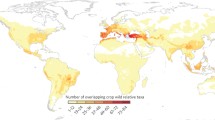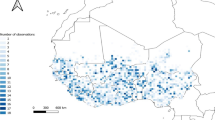Abstract
Geographic Information System (GIS) tools are applied to a comprehensive database of 3514 records of wild Arachis species to assist in the conservation and utilisation of the species by: (a) determining the distributional range of species and their abundance; (b) characterising species environments; (c) determining the geographical distribution of species richness; and (d) determining the extent to which species are associated with river basins. Distributional ranges, climatic variables and indices of endemism for each species are tabulated. A. duranensis Krapov. & W.C. Gregory, the most probable donor of the A genome to the cultivated peanut, is distributed in close proximity to both the proposed donor of the B genome, A. ipaënsis, and the closest wild relative of the cultigen, A. monticola Krapov. & Rigoni. This region in the eastern foothills of the Andes and the adjoining chaco regions of Argentina, Bolivia and Paraguay, is a key area for further exploration for wild Arachis. An area of particularly high species richness occurs in the State of Mato Grosso, close to the Gran Pantanal in southwest Brazil. Seventy-one percent of the species were found to have some degree of association with water catchment areas, although in most cases it was difficult to determine whether this was due to climatic adaptation reasons, restricted dispersal due to geocarpic habit, or the role of watercourses as a principal dispersal agent. In only two cases could climatic adaptation be eliminated as the reason for species distribution.
Similar content being viewed by others
References
C.M. Bianchi-Hall R.D. Keys H.T. Stalker (1991) ArticleTitleUse of protein profiles to characterize peanut cultivars Newsletter of the Association of the Official Seed Analysis 65 25–26
A. Fernandez A. Krapovickas (1994) ArticleTitleChromosomas y evolucion en Arachis (Leguminosae) Bonpladia 8 187–220
K.J. Gaston (1996) Species richness: measure and measurement K.J. Gaston (Eds) Biodiversity, a Biology of Numbers and Difference Blackwell Science London, UK 77–113
W. Gregory M. Gregory A. Krapovickas B.W. Smith J.A. Yarbrough (1973) Structure and genetic resources of peanuts Peanuts – Culture and Uses American Peanut Research and Education Association StillwaterOklahoma 47–133
U. Grieshammer J.C. Wynne (1990) ArticleTitleIsozyme variability in mature seeds of US peanut cultivars and collections Peanut Science 18 72–75
T.M. Halward H.T. Stalker E. LaRue G. Kochert (1991) ArticleTitleGenetic variation detectable with molecular markers among unadapted germ-plasm resources of cultivated peanut and related wild species Genome 34 1013–1020 Occurrence Handle1:CAS:528:DyaK38XhsVGht7c%3D
T.M. Halward H.T. Stalker E. LaRue G. Kochert (1992) ArticleTitleUse of single-primer DNA amplifications in genetic studies of peanut (Arachis hypogaea L.) Plant Molecular Biology 18 315–325 Occurrence Handle10.1007/BF00034958 Occurrence Handle1:CAS:528:DyaK38Xht1antb8%3D Occurrence Handle1731991
R.J. Hijmans M. Cruz E. Rojas L. Guarino (2001) DIVA-GIS, Version 1.4. A Geographic Information System for the Management and Analysis of Genetic Resources Data. Manual International Potato Center LimaPeru
R.J. Hijmans K.A. Garrett Z. Huamán D.P. Zhang M. Schreuder M. Bonierbale (2000) ArticleTitleAssessing the geographic representativeness of genebank collections: the case of Bolivian wild potatoes Conservartional Biology 14 1755–1765 Occurrence Handle10.1046/j.1523-1739.2000.98543.x
R. Hijmans L. Guarino M. Cruz E. Rojas (2002) ArticleTitleComputer tools for spatial analysis of plant genetic resources data: 1. DIVA-GIS Plant Genet. Resour. Newslett. 127 15–19
M. Hopkins A. Casa T. Wang S.E. Mitchell R.E. Dean G.D. Kochert S. Kresovich (1999) ArticleTitleDiscovery and characterization of polymorphic simple sequence repeats (SSRs) in peanut Crop Science 39 1243–1247 Occurrence Handle1:CAS:528:DyaK1MXltVKitrc%3D
A. Jarvis M.E. Ferguson D. Williams G. Mottram L. Guarino H.T. Stalker et al. (2003) ArticleTitleBiogeography of wild Arachis: Assessing conservation status and setting future priorities Crop Science 43 1110–1108
P.G. Jones (1991) The CIAT Climate Database Version 3.41, Machine Readable Dataset Centro Internacional de Agriculture Tropical (CIAT) CaliColombia
P.G. Jones A. Gladkov (1999) FloraMap: A Computer Tool for the Distribution of Plants and Other Organisms in the Wild CIAT CaliColombia
G. Kochert T. Halward W.D. Branch C.E. Simpson (1991) ArticleTitleRFLP variability in peanut (Arachis hypogaea L.) cultivars and wild species Theoretical and Applied Genetics 81 565–570 Occurrence Handle10.1007/BF00226719 Occurrence Handle1:CAS:528:DyaK3MXltlajtLY%3D
G. Kochert H.T. Stalker M. Gimenes L. Galgaro C. Romero Lopes K. Moore (1996) ArticleTitleRFLP and cytogenetic evidence on the origin and evolution of allotetraploid domesticated peanutArachis hypogaea (Leguminosae) Americal Journal of Botany 83 1282–1291 Occurrence Handle1:CAS:528:DyaK28XmvF2isr8%3D
G. Lacks H.T. Stalker (1993) ArticleTitleIsozyme analyses of Arachis species and interspecific hybrids Peanut Science 20 76–81 Occurrence Handle1:CAS:528:DyaK2cXivFCgt7w%3D
M.C. Moretzsohn (2001) Microsatélites em Arachis hypogaea e especies associadas Anais, III Simposio de Recursos Genéticos para a América latina e Caribe19–22 November 2001 IAPAR LondrinaBrazil 81–83
O.G. Paik-Ro R.L. Smith D.A. Knauft (1992) ArticleTitleRestriction fragment length polymorphism evaluation of six peanut species within the Arachis section Theoretical and Applied Genetics 84 201–208 Occurrence Handle10.1007/BF00224001 Occurrence Handle1:CAS:528:DyaK38Xls1Orsbs%3D
S. Raina Y. Mukai (1999a) ArticleTitleGenomic in situ hybridisation identifies the diploid wild progenitors of cultivated (Arachis hypogaea) and related wild (Arachis monticola) peanut species Plant Systematics and Evolution 214 251–262 Occurrence Handle10.1007/BF00985743
S. Raina Y. Mukai (1999b) ArticleTitleDetection of a variable number of 18S-5.8S-26S and 5S ribosomal DNA loci by fluorescent in situ hybridisation in diploid and tetraploid Arachis species Genome 42 52–59 Occurrence Handle10.1139/gen-42-1-52 Occurrence Handle1:CAS:528:DyaK1MXhsVyqsbg%3D
C.E. Simpson S. Nelson J.L. Starr K.E. Woodard O.D. Smith (1993) ArticleTitleRegistration of TxAG-6 and TxAG-7 peanut germplasm lines Crop Science 33 1418
C.E. Simpson J.L. Starr (2001) ArticleTitleRegistration of ȁ8COANȁ9 Peanut Crop Science 41 918
J. Smartt H.T. Stalker (1982) Speciation and cytogenetics in Arachis H.E. Pattee C.T. Young (Eds) Peanut Science and Technology American Peanut Research and Education Society YoukumTexas 21–49
H.T. Stalker (1990) ArticleTitleA morphological appraisal of wild species in section Arachis of peanuts Peanut Science 17 117–122
H.T. Stalker (1992) Utilizing Arachis Germplasm Resources S.N. Nigam (Eds) Groundnut – A Global Perspective International Crops Research Institute for the Semi-Arid Tropics PatancheruIndia 281–295
H.T. Stalker M.K. Beute B.B. Shew K.R. Barker (2002a) ArticleTitleRegistration of two root-knot nematode-resistant peanut germplasm lines Crop Science 42 312a–313a
H.T. Stalker M.K. Beute B.B. Shew T.G. Isleib (2002b) ArticleTitleRegistration of five leafspot-resistant peanut germplasm lines Crop Science 42 314–316
Stalker H.T. 1992. Utilizing Arachis Germplasm Resources. In: Nigam S.N. (ed.), Groundnut – A Global Perspective. Proceedings of an International Workshop. 25–29 November 1991. Inter-national Crops Research Institute for the Semi-Arid Tropics, Patancheru, India, pp. 281–295.
H.T. Stalker R.L. Lynch (2002) ArticleTitleRegistration of four insect-resistant peanut germplasm lines Crop Science 42 313–314 Occurrence Handle11756307
H.T. Stalker J.P. Moss (1987) ArticleTitleSpeciation, cytogenetics, and utilisation of Arachis species Advances in Agronomy 41 1–40
H. Stalker T. Phillips J.P. Murphy T.M. Jones (1994) ArticleTitleVariation of isozyme patterns among Arachis species Theoretical and Applied Genetics 87 746–755 Occurrence Handle10.1007/BF00222901 Occurrence Handle1:CAS:528:DyaK2cXlslGgt7k%3D
M.P. Tombs (1963) ArticleTitleVariant forms of arachin Nature 200 1321–1322 Occurrence Handle1:CAS:528:DyaF2cXktVarsw%3D%3D
USGS Hydro1k South America 2000. Drainage Basins, http://edcdaac.usgs.gov/gtopo30/htdro/sa_basins.html
World Conservation Monitoring Centre 2000. Global Protected Areas Database V4.0, WCMC, CambridgeUK.
Author information
Authors and Affiliations
Corresponding author
Rights and permissions
About this article
Cite this article
Ferguson, M., Jarvis, A., Stalker, H. et al. Biogeography of wild Arachis (Leguminosae):distribution and environmental characterisation. Biodivers Conserv 14, 1777–1798 (2005). https://doi.org/10.1007/s10531-004-0699-7
Received:
Accepted:
Issue Date:
DOI: https://doi.org/10.1007/s10531-004-0699-7




